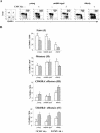Long-term cytomegalovirus infection leads to significant changes in the composition of the CD8+ T-cell repertoire, which may be the basis for an imbalance in the cytokine production profile in elderly persons
- PMID: 15731261
- PMCID: PMC1075718
- DOI: 10.1128/JVI.79.6.3675-3683.2005
Long-term cytomegalovirus infection leads to significant changes in the composition of the CD8+ T-cell repertoire, which may be the basis for an imbalance in the cytokine production profile in elderly persons
Abstract
In spite of the present belief that latent cytomegalovirus (CMV) infection drives CD8+ T-cell differentiation and induces premature immune senescence, no systematic studies have so far been performed to compare phenotypical and functional changes in the CD8+ T-cell repertoire in CMV-infected and noninfected persons of different age groups. In the present study, number, cytokine production, and growth potential of naive (CD45RA+ CD28+), memory (CD45RA- CD28+), and effector (CD45RA+ CD28- or CD45RA- CD28-) CD8+ T cells were analyzed in young, middle-aged, and elderly clinically healthy persons with a positive or negative CMV antibody serology. Numbers and functional properties of CMVpp65(495-503)-specific CD8+ T cells were also studied. We demonstrate that aging as well as CMV infection lead to a decrease in the size of the naive CD8+ T-cell pool but to an increase in the number of CD8+ effector T cells, which produce gamma interferon but lack substantial growth potential. The size of the CD8+ memory T-cell population, which grows well and produces interleukin-2 (IL-2) and IL-4, also increases with aging, but this increase is missing in CMV carriers. Life-long latent CMV infection seems thus to diminish the size of the naive and the early memory T-cell pool and to drive a Th1 polarization within the immune system. This can lead to a reduced diversity of CD8 responses and to chronic inflammatory processes which may be the basis of severe health problems in elderly persons.
Figures





References
-
- Appay, V., P. R. Dunbar, M. Callan, P. Klenerman, G. M. Gillespie, L. Papagno, G. S. Ogg, A. King, F. Lechner, C. A. Spina, S. Little, D. V. Havlir, D. D. Richman, N. Gruener, G. Pape, A. Waters, P. Easterbrook, M. Salio, V. Cerundolo, A. J. McMichael, and S. L. Rowland-Jones. 2002. Memory CD8+ T cells vary in differentiation phenotype in different persistent virus infections. Nat. Med. 8:379-385. - PubMed
-
- Aspinall, R., and D. Andrew. 2000. Thymic involution in aging. J. Clin. Immunol. 20:250-256. - PubMed
-
- Blasko, I., F. Marx, E. Steiner, T. Hartmann, and B. Grubeck-Loebenstein. 1999. TNF-α plus IFN-γ induce the production of Alzheimer β-amyloid peptides and decrease the secretion of APPs. FASEB J. 13:63-68. - PubMed
-
- Blasko, I., T. L. Schmitt, E. Steiner, K. Trieb, and B. Grubeck-Loebenstein. 1997. Tumor necrosis factor alpha augments amyloid beta protein (25-35) induced apoptosis in human cells. Neurosci. Lett. 238:17-20. - PubMed
-
- Brenchley, J. M., N. J. Karandikar, M. R. Betts, D. R. Ambrozak, B. J. Hill, L. E. Crotty, J. P. Casazza, J. Kuruppu, S. A. Migueles, M. Connors, M. Roederer, D. C. Douek, and R. A. Koup. 2003. Expression of CD57 defines replicative senescence and antigen-induced apoptotic death of CD8+ T cells. Blood 101:2711-2720. - PubMed
Publication types
MeSH terms
Substances
LinkOut - more resources
Full Text Sources
Medical
Research Materials

